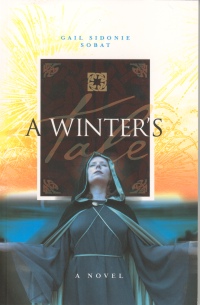| ________________
CM . . .
. Volume XI Number 6 . . . .November 12, 2004
excerpt:
Sobat introduced a copper-haired, emerald-eyed young witch in Ingamald (2001) and continues Ingamald's adventures five years later in volume two of a planned trilogy. The Winter of the tale, Morton Cornelius Winter, "his hideous highness, swollen in sloth and gluttony," the "self-proclaimed Lord of Hinterlund," causes "a malaise in the land." From the safety of her village Ingamald, learning of the trouble, insists "Hinterlund is for all who dwell here. Creature and human and dwarf and people of the Rowan," and resolves to save as many victims as she and her trusted associates can manage from Winter's determination to purge the "unworthy" and attain complete dominance. With her motley group of friends, unworthy in Winter's view, Ingamald embarks on a dangerous quest to overcome the tyrant and return peace and freedom to Hinterlund. She sets out to break Winter's seven prohibitive proclamations aimed at cementing his control and assigns her group of seven special areas of operation, hers the most dangerous. Learning that Winter's information comes through Tabula, an amoral "obsidian teller" who presents visions of events as whim dictates, Ingamald gains insight into his modus operandi. Winter controls the dwarf Dagnott as his smithy manufacturing lethal torture weapons, the hunchback Didion as his aide enforcing his edicts, and the alchemist Svalbaard (Ingamald's father) as his court fool; they reluctantly obey his brutal commands while pursuing their private rebelion. The struggle between the evil of the tyrant and the good of those he deems unworthy forms the essential conflict in the novel. In a dramatic climax when evil appears certain to triumph, Ingamald causes a "glacial cold" to creep "throughout the city, around its wall, and beyond" whereby "Hinterlund succumb[s] to a frozen sleep." Sobat ends her tale abruptly with Ingamald and Yda, in the convention of fairy tales, stepping through "the looking glass" and presumably into the third volume of the planned trilogy. In the best tradition of fantasy, Sobat takes the reader into the make-believe world of Hinterlund from the opening chapter. "The novel is fantasy and, therefore, the plot details and characters are allegorical references to today's onerous list of dictators despots and oppressive societies - including our own and our southern neighbour," asserts Sobat. The original idea for the story, she explains, "came from my lifelong fascination with witches and my interest in fairy tales, magic realism and literature of the fantastic. My research . . . has focused on alchemy, sorcery, wicca, witch hunts, medieval torture and the Inquisition, medieval life, medieval women's biographies, fairy tale and mythology." The depth of her research is evident throughout A Winter's Tale with magic woven artfully with realism as Ingamald seeks to save her world from the oppressor. "Magic," Ingamald explains, "must be exercised with reverence. Magic is for need, not for play." Ingamald is an appealing and dynamic heroine who uses her "power, formidable and freakish" to tend "the aged, the infirm," and "sick infants and children," as well as to rescue victims of persecution. Although her fiery temper wars with her nurturing nature, even when she is determined to destroy Winter using a deadly pox to infect him, she heeds her late mentor Hana's dictate that "wicca must not be used for ill." The secondary characters among Ingamald's coterie likewise display primarily laudable qualities while those among Winter's faction are a complex blend of good and evil who must practice duplicity to survive. Using language rich in dialect and mystic words and phrases, Sobat weaves italicized segments and poetry into her prose delineating Ingamald's "arcane art" in mystical sequences. The skillfully detailed descriptions of Hinterlund's landscape and culture and the powerful imagery provide a strong foundation around which the plot revolves. The story features plenty of action and tension, but the complex language and changing points of view may challenge even experienced readers of fantasy. References to events of volume one of the trilogy might have been more clearly incorporated into this sequel whose abrupt open-ended finale signals Ingamald's future adventures. "Ingamald," according to Sobat, "is a young woman like those in this century, with corresponding concerns, frustrations and interests." Targeted at older readers, A Winter's Tale should engage fans of the genre and have them look forward to Sobat's final volume of Ingamald's journey. A black and white pictorial map of Hinterlund is provided. Recommended. Darleen Golke of Abbotsford, BC, is a librarian between assignments.
To comment
on this title or this review, send mail to cm@umanitoba.ca.
Copyright © the Manitoba Library Association. Reproduction for personal
use is permitted only if this copyright notice is maintained. Any
other reproduction is prohibited without permission.
NEXT REVIEW |
TABLE OF CONTENTS FOR THIS ISSUE
- November 12, 2004.
AUTHORS |
TITLES |
MEDIA REVIEWS |
PROFILES |
BACK ISSUES |
SEARCH |
CMARCHIVE |
HOME |
